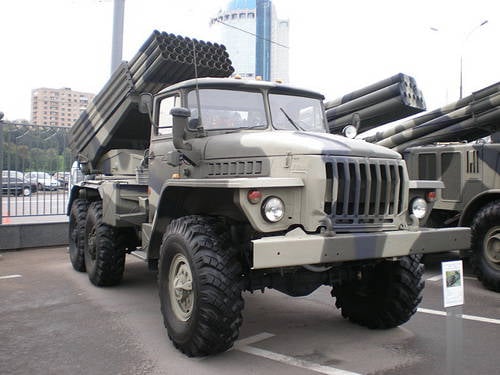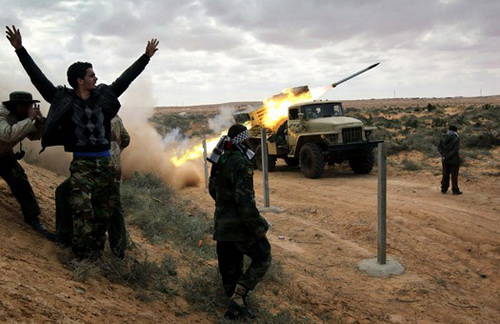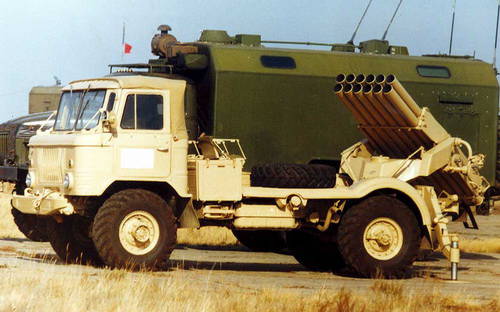Hail on the head of the enemy
Purpose and features
The task of field 122-mm divisional MLRS BM-21 "Grad" is the destruction of open and sheltered enemy personnel, unarmored and lightly armored vehicles, mortar and artillery batteries, command posts, as well as other targets in areas of concentration of the enemy and during combat operations.
The Grad system has high dynamic qualities and good maneuverability, which makes it possible to more effectively use it in conjunction with armored vehicles in the conditions of the march and in the front line during the conduct of hostilities. The BM-21 is manually reloaded using a transport-charging vehicle (a three-axle ZIL-131 with 2 racks, each for 20 projectiles).
Composition
The composition of the MLRS "Grad" includes the combat vehicle BM-21 on the Ural-375D chassis ", unguided rockets of caliber 122 mm., Fire control system and transport-charging vehicle - TZM 9Т254. To prepare the source data for firing, the battery BM-21 contains the 1В110 “Birch” machine, manufactured on the chassis of the GAZ-66 truck.

BM-21 is an all-terrain automobile chassis with the installation of an artillery unit in the rear of the vehicle. The artillery unit includes a package of 40 tubular guides mounted on a rotating base, turning and lifting mechanisms, sighting devices, and other equipment. Guidance can be carried out both in the horizontal and vertical plane. In the guides (internal diameter 122,4 mm. And length 3 m.), The U-screw groove is made to give the projectile a rotary motion. The package of guides includes 4 rows of 10 tubes in each, and together with the sights it is mounted on a rigid welded cradle. The guidance mechanisms provide guidance in a vertical plane (from 0 to + 55 degrees) and in the horizontal one - 172 degrees (70 degrees to the right and 102 degrees to the left of the car). Guiding of guides is made by the electric drive.
The fire control system (LMS) ensures salvo or single firing from the installation cabin or from the remote control from a distance to the 50 m. The duration of a full “Grad” salvo is 20 seconds. Shooting can be conducted in a wide temperature range (from -40 to + 50 degrees) with minimal (due to the use of computers and the sequential descent of projectiles from the rails) rocking the machine. Time to bring the MLRS "Grad" from the traveling to the combat position does not exceed 3,5 minutes. BM-21 has a high cross, and on the highway can reach speeds of up to 90 km / h, the installation is able to overcome the ford with a depth of one and a half meters. The machine is equipped with radio station Р-108М and fire extinguishing means.
The upgraded version of the BM-21-1 uses the Ural-4320 diesel as a chassis and has ASUNO - an automated guidance and fire control system, APP - preparation and start-up equipment, and NAP SNS - a satellite navigation system. These systems provide: initial orientation of a package of guides, determination of initial and current coordinates during movement with showing the location and route of movement on an electronic map of the area on a computer screen, aiming a package of guides from the cab without exiting the calculation and using aiming devices, automated remote data entry into fuses rocket projectiles, launching rocket projectiles from the cabin without exiting the calculation.
The main types of used rockets:
9М22 - used at a distance from 5 to 20,4 km. At the maximum firing range, lateral dispersion is - 1 / 200 in range - 1 / 130. For firing at a smaller range (12-15,9 km.), A small brake ring is used, and for firing at a distance of less than 12 km, a large brake ring. The length of the projectile is 2,87 m., Weight - 66 kg. (the head part - 18,4 kg. contains 6,4 kg. explosive). The projectile is equipped with a head percussion fuse with a long-distance cocking of the RTM, as well as an RTM-U with 3-settings: for instant action, small and large deceleration. The arming of the fuse occurs after the projectile has gone off the guide and has moved away from the installation on 150-450 meters.

9M22U is a widely used type of NURS with high-explosive fragmentation warhead. From the projectile 9М22 differs in a large number of fragments. Powder charge with a mass of 20,45 kg provides the maximum firing range to 20,4 km with a projectile speed of up to 690 m / s.
9М22С - missile with incendiary warhead.
9М23 “Leica” is a specialized fragmentation projectile with a chemical warhead (1,8 kg of a conventional explosive and 3,11 kg of a chemical P-35, or 1,39 kg of a conventional explosive and 2,83 kg of a chemical P-33). The projectile is equipped with mechanical and radar fuses, the latter is triggered at an altitude of 1,6-30 meters. When undermined, 760 gives fragments of mass in 14,7 g. The firing range when using a radar fuze is 18,8 km.
9М43 - rocket projectile for blinding and masking curtains in front of the battle formations of their troops and enemy troops with a mass of 56,5 kg. It is used at a distance of 5-20,1 km. Consists of 5 smoke elements of red phosphorus weighing in 0,8 kg. A volley of 10 shells creates a solid curtain 1 km wide on the front and 0,8-1 km in depth for 5,3 minutes.
9М28К - a missile for remote setting of minefields. Mass - 57,7 kg, mass of the head part - 22,8 kg (contains 3 mines in 5 kg), firing range 13,4 km. In order to mine the 1 km. front, requires the use of 90 shells. The time of mines self-destruction after installation is from 16 to 24 hours.
9М16 - missile for the installation of anti-personnel minefields. The mass is 56,4 kg, the mass of the head part is 21,6 kg (contains 5 anti-personnel fragmentation mines POM-2 weighing 1,7 kg each), the maximum range of firing is 3,4 km. A volley from 20 shells can mine the 1 km of front. Mines can self-destruct through the 4-100 hours after installation.
9M28F - a missile with a powerful high-explosive part. The mass of the projectile is 56,5 kg, the mass of the warhead is 21 kg, the mass of the explosive is 14 kg, the firing range is 1,5-15 km.
9М28Д is a missile for setting radio interference in the HF and VHF bands to impede enemy radio communications at the tactical level. A set of 8 shells with the same dynamic and weight-dimensional characteristics can suppress radio equipment in the range from 1,5 to 120 MHz. Ammunition firing range - 18,5 km, projectile weight - 66 kg, warhead weight - 18,4 kg. The continuous operation time of the interference transmitter is 1 hour, the range of interference 700 meters.
9М42 - the illumination jet projectile for the Illumination system provides illumination of an area with a diameter of 1 km from a height of 450-500 meters for 90 seconds while ensuring the level of illumination with 2 lux power.
Condition to date
In our time, the Grad MLRS is in service with more than 30 different countries. As of 2007 year in the land forces of Russia, there were 2500 installations BM-21 (367 in service, the rest in reserve). The coastal defense forces are still 36 installations. On armies of armies of other countries is about 3000 installations "Grad". The MLRS Grad for decades was produced in large quantities and is the most massive rocket launcher of this class. For example, only at Motovilikhinsky plants 3000 BM-21 was produced and 3 million shells were manufactured for them.

MLRS "Grad" became the basis for the creation of such systems as:
9K59 "Prima" is a multipurpose reactive system of salvo fire of increased power - 50 guides.
Grad-V is an airborne unit with 12 guides for firing all types of projectiles based on GAZ-66.
"Grad-M" is a ship analogue of the MLRS, intended for installation on amphibious assault ships of the Navy. Development began in 1966. The complex consists of a launcher with 40 rails, firing controls, a rangefinder sighting device with a laser rangefinder. After revision and testing in 1978, it was put into service.
BM-21PD "Dam" - reactive volley fire system, designed to combat maritime saboteurs and submarines, is used to protect maritime borders and naval bases. Developed in 1980's.
The Grad MLRS was so popular that many countries produced copies of it: in Egypt, Iraq, India, China, Pakistan, Romania and North Korea. Many of these countries also produced rockets for them. The Italian MLRS FYROS 25 / 30 is compatible with the MLRS Grad. In 1975, the installation of RM-70 was designed in Czechoslovakia, which was created by placing the artillery unit of the Grada on the chassis of the Tatra-813 truck.
Information